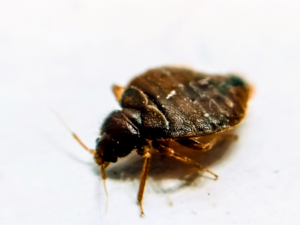Home / Blog / Ticks / How to Get Rid of Ticks in Your House
How to Get Rid of Ticks in Your House

Scientifically reviewed by Daniel Baldwin, BCE, CCFS, CP-FS
-Published on October 17, 2024
-Updated on March 19, 2025
Small and persistent, ticks can enter your home by hitching a ride on pets or people who unknowingly carry ticks on their clothing, shoes, or even bags. If this happens, you will want to take measures to address the issue and protect yourself and your pets from tick bites. Understanding how to get rid of ticks at home and also how to prevent ticks from entering your living space is essential to staying safe from these pests.
Here’s what you need to know.
How to get rid of ticks in the home
It’s important to note that ticks are generally outside-loving insects. It’s rare to have an in-home infestation, although people and pets can certainly bring ticks into the home unwittingly and then you may see them throughout the home. Getting ticks out of the home is mostly about keeping them from hitching a ride inside on your pets, your picnic blankets, or your own clothing, and then removing them quickly if they do get indoors.
The main ways to address ticks inside the house are:
- Professional Tick Control: Preventing ticks starts with reducing their numbers around your home in the first place. Treat for them using professional pest control services in your yard and around the house.
- Protection outside: Wearing tick repellent and covering your head and extremities when out in tick-heavy areas.
- Inspections: Inspecting yourself, your clothes, your pets, and your soft surfaces after you come inside.
- Disposal: Immediately removing any ticks you find on your skin, your pets, or anywhere crawling around inside your house.
- Toss things in the Dryer: Drying your clothing or blankets on high right when you come inside to kill any ticks you may have missed.
- Vacuuming: Vacuum your floors, furniture, and pet areas thoroughly to remove ticks. Be sure to dispose of the vacuum bag or contents immediately.
Most natural oils and household products that are suggested for removing ticks inside the home will only be minimally effective. Things like vinegar, rubbing alcohol, baking soda, salt, or essential oils fall into this category.
What are ticks?
Ticks are part of the arachnid class and are related to spiders, scorpions, and mites. Contrary to popular belief, ticks crawl but don’t jump, fly, or drop from trees. Ticks come in all sizes, with the smallest being a nymph, which is only about the size of a poppy seed. In comparison, an adult female dog tick can be as large as 15 mm in length after feeding.
Ticks feed on mammals’ blood, and adult ticks grow in size as they become engorged. The ticks that most commonly bite humans are the black-legged tick (also known as the deer tick), the Lone Star tick, the American dog tick, and the brown dog tick.

Do ticks spread diseases?
Yes, ticks spread disease by passing along viruses, bacteria, and parasites. When a tick bites, it latches onto the skin and stays there for days, sucking on your or your pet’s blood, becoming engorged with it. While a tick feeds, germs in its saliva can transmit to the host, spreading disease.
Diseases spread by ticks
Ticks can spread several illnesses, but the most common diseases transmitted to humans include:
Lyme Disease: Lyme disease spreads through infected deer tick bites and causes fever, chills, headaches, and a rash. If left untreated, people who contract this disease can develop joint pain, heart palpitations, nerve pain, and brain inflammation.
Rocky Mountain Spotted Fever: The American Dog, Brown Dog, and Lone Star ticks spread this disease. Although the initial symptoms include headaches, fever, and nausea, more severe, life-threatening symptoms can occur as the disease progresses.
How do ticks get into your house?
Ticks are usually brought into the home on pet fur or clothing after being outdoors. When you garden, play in the yard, or take a walk and brush against tall grass or weeds, ticks can latch onto you, your clothing, or your pet without your knowledge.
Ticks that nest in houses
Most ticks prefer to make their homes outdoors, but the brown dog tick is known for infesting homes. Once dogs have carried these ticks indoors, the critters adapt quickly to nest in a home where they have good access to the blood they need.
The eggs of brown dog ticks are dark brown and shaped like a sphere. The tiny larvae measure about 0.54 mm long and 0.39 mm wide. Adults have four pairs of legs, are reddish-brown, and grow as long as 3.18 mm and 1.68 mm wide. They have no markings on their backs. Female brown dog ticks can grow to about the size of a raisin as they feed. They can lay thousands of eggs after feeding.
Where ticks lay their eggs in your home
The adult brown dog tick might lay her many dark-brown eggs in the cracks or crevices of ceilings, on ledges, and other gaps around a home. After she lays her eggs, the female brown dog tick dies. The larvae hatch one to two weeks later, bringing hundreds or thousands more ticks into the home.

Where to look for brown dog ticks
Check your dog carefully for these ticks whenever your pet comes home from being outside, at a dog kennel, or at a pet groomer’s session. Look carefully for tick eggs, nymphs, or adults on the dog’s head, ears, beneath the collar, and in other areas that are warm and hidden on a dog.
Also, check your dog’s bed and blankets, cleaning them regularly with hot water to keep ticks at bay. Use the clothes dryer on its highest heat setting to kill any ticks that may be hiding.
Brown dog ticks can gain entry to your home not only on pets but also through small cracks and crevices that are difficult for us to spot. Once ticks enter a house, they will begin laying eggs. A tick infestation in your home can be challenging to control without the help of professionals like Hawx Pest Control.
How to prevent ticks from coming indoors
To prevent ticks from entering your home, perform thorough tick checks on yourself and your pets after being outdoors. Check your skin, clothing, bags brought in from outdoors, and pets’ fur for the presence of ticks. Use a magnifying glass, as some ticks are very tiny.
When checking dogs, look around your pets’ ears, eyelids, beneath the collar, under and between the legs and toes, and around the tail. Regular grooming and bathing of pets can also help with home tick removal.
For humans, look carefully anywhere skin folds or where clothes start—such as behind the ears, on the scalp, around the waist, under the arms, at the sock line, and behind the knees.
How to keep ticks off when outdoors
When outside, avoid walking through dense bushes or tall grasses where ticks hang out, especially during your local tick season. In most parts of the United States, tick season is from late March through September, as these pests can be prevalent throughout the summer and autumn months. The tick season typically ends when temperatures drop below freezing in late fall.
Ticks can easily attach to your skin without feeling them when brushing up against vegetation. Wear closed-toe shoes and socks to help avoid getting these critters on you and bringing them into your house. Use long pants, preferably with the bottoms tucked inside your socks, long-sleeved shirts, and a hat when walking through wooded areas.
Preventing ticks in your home also involves keeping your yard well-maintained. Regularly mow your lawn, remove leaf litter, and create a barrier between your yard and wooded areas to discourage ticks from entering your property.
Remember: Tick-borne diseases can be dangerous, so if you suspect you have an infestation, contact a professional pest control company to ensure your safety.
What to do if you find a tick in your house
First, check every person and pet for ticks on skin and clothing. Then, place all clothes worn before coming indoors in a hot dryer. This helps kill ticks in the house that might be hiding in that clothing.
A deer tick that hasn’t fed yet will only survive indoors for up to 24 hours. However, if a tick is sitting on wet clothing, it can live for a few days. Check damp locations for ticks, as they may hide in these well-suited areas.
Knowing how to remove ticks at home safely is important. Use fine-tipped tweezers to grasp the tick as close to the skin’s surface as possible and pull upward with steady pressure. Avoid crushing the tick’s body. After removal, clean the bite area and your hands with rubbing alcohol or soap and water.
How do you clean ticks out of a room?
If you see a tick, vacuum it up or flush it. Then complete a thorough vacuuming of your entire home, including rugs and furniture. Ticks can lay their eggs in various nooks and crannies throughout the house. Check near baseboards, around windows and doors, and on furniture, rugs, and draperies while vacuuming.
Brown dog ticks actively try to live inside a house where conditions are favorable. If you find a Brown dog tick in your home, there may be many more if they have laid eggs. If you suspect you have a nest, the best plan of attack is to call professional pest control services.

Tick pest control services
Hawx is a leader in the pest control industry, solving your current problems and helping to prevent future infestations from taking place. Our qualified technicians are friendly and prepared to help you manage pests, including ticks.
At Hawx Pest Control, we offer comprehensive solutions to remove ticks from your property using a combination mister and granule process to treat the exterior areas where ticks are likely to live and breed. Our professional technicians are trained in these methods of effective tick removal and can provide guidance on how to prevent ticks from returning. Contact us today for a free estimate.
Related Articles
Visit our blog to learn more.
→





